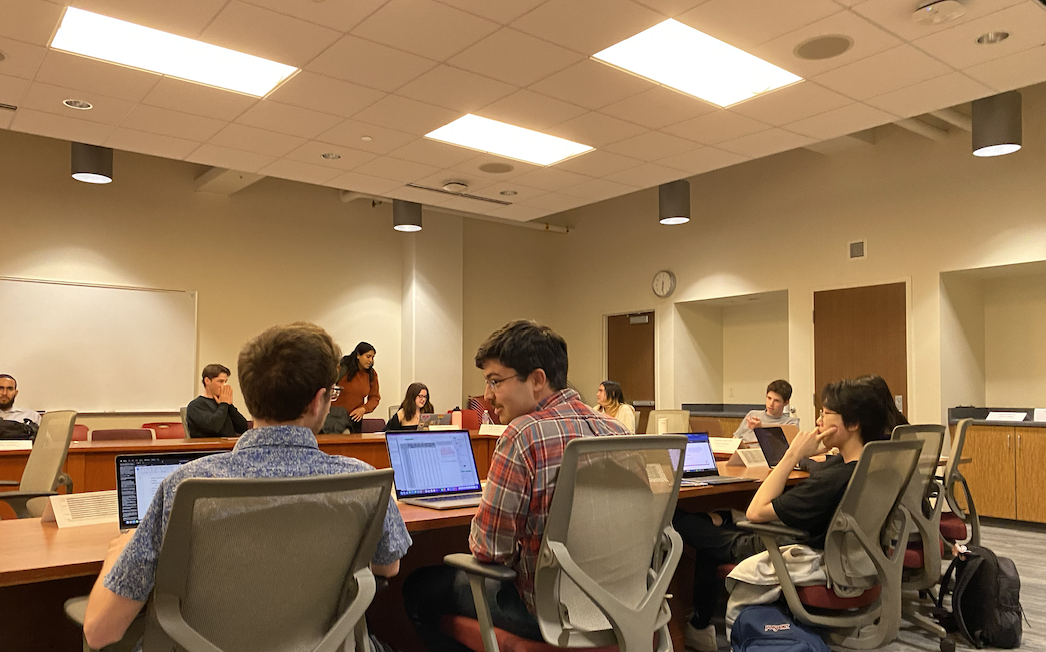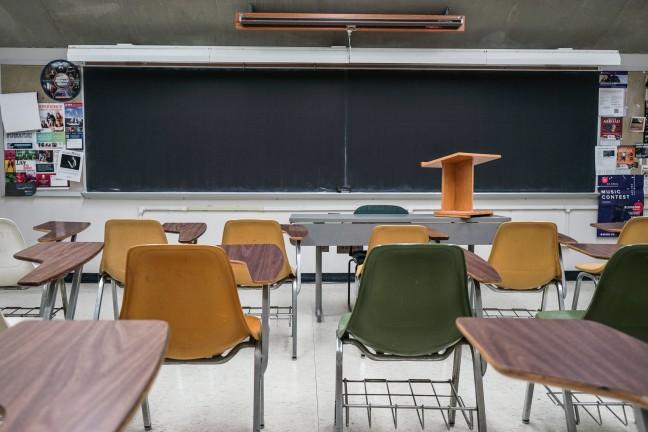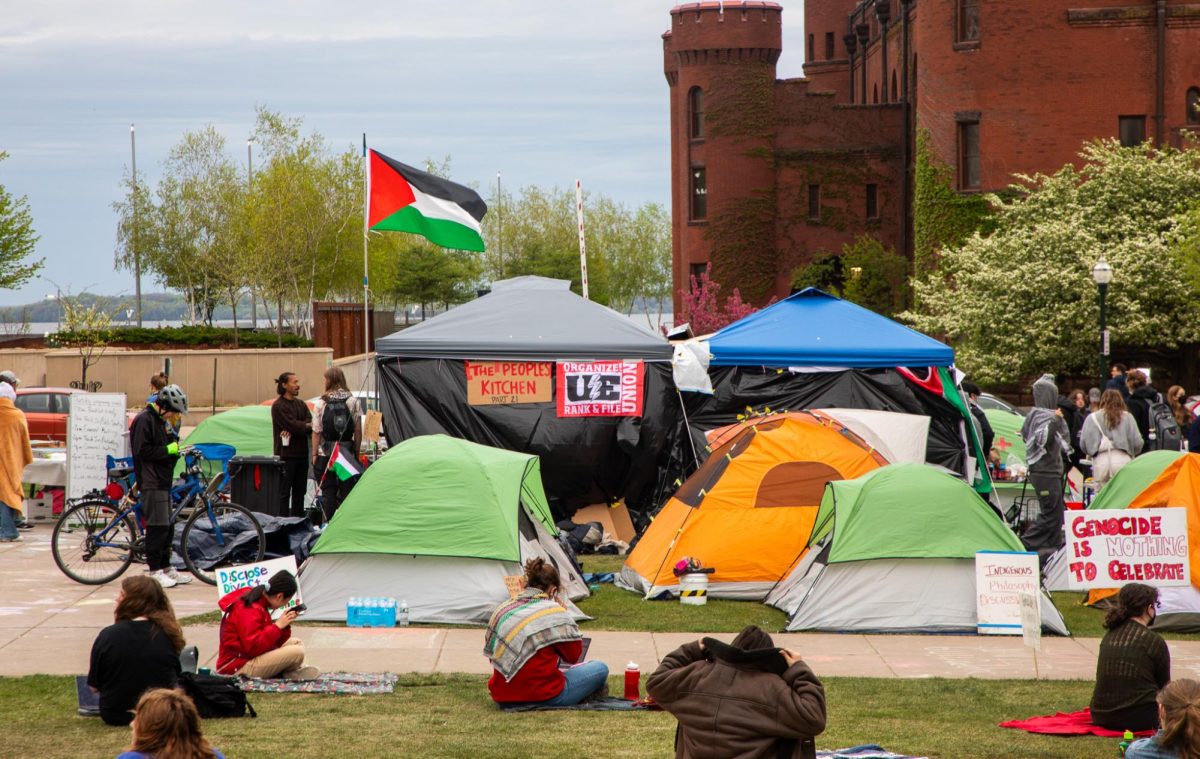As Rishard Bournes enters Grainger Hall to attend his business classes, the mere sight of numbers — clocks indicating the time of day across the world — floods him with an eerie feeling, if only fleetingly.
Seeking “achievement in every endeavor,” the Kappa Alpha Psi member pushes this feeling to the back of his mind as he diverts his attention to his personal finance classes. Cognizant that this eerie feeling is not just attributed to time but classroom and campus climate, Bournes navigates through his fourth year at the University of Wisconsin as one of 1,559 African American undergraduate students.
The rigidity of the business school climate and the rigidity of the coursework in his major was just the beginning of Bournes’ struggles as a student of color. Like other members of the first black Greek organization in the state, Bournes found success in his endeavors — but limited support.
While his POSSE advisors and cohorts provided the Chicago native with the academic and social support needed to get the most out of his college experience, Bournes often felt like the supplemental support he received was what he ultimately had to seek for himself.
But unlike Bournes, many students of color are left too drained to take those extra steps as they understandably struggle to get by academically and socially.
The Center on Wisconsin Strategy reported in October that while diversity in Wisconsin is increasing, so are racial and ethnic disparities — especially in terms of access to UW. But while efforts to diversify the student body are underway, enrolled students of color struggle to anchor their academic efforts at a primarily-white institution to which they feel disconnected.
Resource drought
Every student’s first-year experience looks different, but students of color feel especially underprepared for the UW experience, Associated Students of Madison Equity and Inclusion Chair Agalia Ardyasa said. As a Student Orientation, Advising and Registration advisor, Ardyasa noticed first-year students of color have a particularly tough time transitioning from high school to college.
“I realized we have academic support, but sometimes the issue is how do we let the students know and how do we make sure they they’re utilizing them,” Ardyasa said. “We have to think about making sure that we’re creating inclusive classrooms as well. We’re excited that many students are experiencing certain spaces in the university inclusively, we just want to raise that number overall so that all students are having the same experience.”
Ardyasa added that students of color often miss out on resources because they either don’t know about them, they lack the motivation to take that support or such resources are understaffed.
The Center for Academic Excellence, the Multicultural Student Center and the Center for Educational Opportunity are a few of the many units on campus Ardyasa cited. While these are just some ways the university shows it cares, Ardyasa said they shouldn’t stop there.
Even students who are part of scholarship programs designed to foster diversity like PEOPLE or POSSE feel underprepared to navigate a predominantly white campus, because their SOAR sessions are with other students in the same program and are not an accurate reflection of the campus at-large.
Because of that disconnect, Ardyasa said first-year students need further support.
Regardless, these scholarship programs address both the need of the university to close racial disparities and expand access. They make the university more accessible to students of color throughout the nation and in Wisconsin while also supporting students’ needs once they get here.
Bournes was able to make decisions about his field of study because of guidance from his POSSE advisor. If he weren’t in POSSE, Bournes said he would have had to go the extra mile to seek out that same support. Just knowing people through POSSE as a first-year student was very helpful, Bournes said.
As an incoming freshman, UW junior Fuad Ahmed knew he wanted to do something hands-on for a career. He was able to access tutoring for additional help in his engineering classes, but Ahmed suggested UW could provide more outreach to future students of color when it comes to things like picking a major and prepping them for the college experience.
Sherri Charleston, a UW vice provost who focuses on diversity and inclusion, said CAE, CEO, the Learning Communities for Institutional Change and Excellence and various scholarship programs provide resources to students of marginalized identities.
“Diversity is our strength here at the University of Wisconsin-Madison, but it’s really a noun. It just describes sort of who we are,” Charleston said. “The act of creating inclusive environments — that’s action.”
Charleston said the UW Division of Diversity, Equity and Inclusion could provide centralized accountability for improving campus climate. Created eight years ago, Charleston said the division’s work is informed by cutting-edge research on campus diversity and inclusion.
The division works to increase diversity in many ways — socioeconomically, regionally, politically, religiously as well as by race, ethnicity, gender and sexual orientation, Charleston said.
Roopa Rawjee, the assistant dean of international student services, said the academic success of first-year international students often reflects their different educational backgrounds. But the impact of political, social and financial stressors can be magnified for international students.
As an international student, Ardyasa felt some of those struggles throughout her first year, causing her grades to suffer. The rigorous curriculum, class sizes and competitive environment came as a shock for Ardyasa who came from a small school in Indonesia.
After receiving that wake-up call, Ardyasa put in the extra work to turn her GPA around during her sophomore year by seeking out campus resources. Now, as a member of ASM, she advocates for students of color who faced similar difficulties — especially other international students, who Ardyasa admires for their ambition.
“One thing that I knew is I wanted to make an impact,” Ardyasa said. “Getting involved with something you’re passionate about is a really easy way and really practical way to feel comfortable and welcome on campus.”
UW senior Riley Tsang also found community through his advocacy work at the MSC. But when he first started taking classes for his major, hoping to find a more diverse and representative classroom, he was met with disappointment.
In his early days at UW, Tsang felt comfortable addressing his concerns over course content with his professors, many of whom were white — but such repeated conversations resulted in little action.
“As a result I think as a senior, I might say something once or twice to a professor,” Tsang said. “But I’ve noticed that a lot of my fellow students of color just don’t even try anymore because they know that the educational curriculum isn’t designed for them.”
After examining history of intolerance, UW grapples with creating more inclusive future
Small talk
Arthur Rainwater, a UW educational policy and leadership clinical professor, said diversity is fundamental to the higher education experience.
“I have to be able to understand that you look at the world through different eyes than mine — and that the way you look at the world is just as okay as how I do,” Rainwater said.
Over the last decade, students of color have increased from 12 to 16 percent of the student body, according to the 2019 campus climate progress report.
Still, white students comprised 73 percent of UW’s undergraduate class of 2017.
“The schools, the people who provide the services, the classroom represents the campus,” Bournes said.
As classes, services and even jobs reflect the majority-white campus, Bournes said white people will remain at the forefront. The campus, the culture, the classes — they weren’t built for people of color, he said.
According to the campus climate survey, respondents recommended the university focus on improving and creating more inclusive classrooms. While students generally felt respected by instructors in the classroom, only 65 percent felt their comments were respected by other students in class.
On top of that, 25 percent of students felt expected to represent their identity in class at some point — an experience described negatively by most students of color.
“We have to think about making sure that we’re creating inclusive classrooms as well,” Charleston said. “We’re excited that many students are experiencing certain spaces in the university inclusively, we just want to raise that number overall so that all students are having the same experience.”
Sofia Khan, a UW sophomore majoring in computer science and political science, said she experiences a majority-white classroom in different ways, depending on which of her two divergent majors the course falls under.
As a Muslim student in the political science class “Islam and Politics,” Khan sometimes feels pressured to talk about topics like the War on Terror. When it comes to moments like these, Khan chooses to take the backseat during discussion.
“It’s not my duty as the one person of color in the room to educate everyone else here about some type of topic,” Khan said. “Just because I know about current issues that doesn’t mean I’m as well-read or qualified to talk about it as the TA in my class should be.”
She feels that being a Pakistani-American Muslim does not mean she should adhere to tokenized roles and discuss issues wrongfully associated with her identity simply for the sake of representation.
Most of Khan’s TAs for her political science discussions are white, and because they discuss current events, there is a disconnect between their perspectives. While she does not expect her discussion leaders to agree with her, Khan feels less inclined to engage with them when they hold a majority point of view that does not align with her own experiences. “If these white people are in class and they’re reading about how your communities have been oppressed or excluded or marginalized in this way or that, they’re only going to think of your communities in that regard — as opposed to the traditions, the strengths and the community that we formed.”
“It’s like a leap of faith — is the TA going to back me up on this, or are they thinking the same way that everyone else in this classroom is thinking?” Khan asked.
More often than not, Khan — as one of the few people of color in her discussions — chooses to participate and get the most out of her academic experience. But sometimes, she feels she is compensating for the silence of her “scarily apathetic” white classmates.
Khan said her white classmates — which, again, make up the majority of her discussions — are either silent on issues or hold monolithic views, especially when it comes to non-Western matters.
“Their viewpoints on it are really unaffected — and because of that, they’re very unwilling to talk about things,” Khan said. “I’m not asking them to have the same viewpoint as me, but rather to just be able to engage in it, and they don’t.”
This not only takes an emotional and mental toll on students of color, but also negatively affects their academic experiences, Khan said. In discussions, she feels like she is just talking to herself.
Tsang attributed this phenomenon to the fact that a lot of the material students of color are learning in class are not designed for them, but rather for white students. Elementary topics like how to work with communities of color or how to be culturally competent are issues students of color are already engaging in at an advanced level through their own personal experiences.
“As a result of there not being a lot of faculty of color at our university, and as a result of the way that we structure the ethnic studies requirement in our university — I think that a lot of the material institutionally in the sociology area about working with populations of color is pretty elementary, which leads to a lot of students disengaging,” Tsang said.
Because Tsang’s sociology classes are mostly presented from a white perspective, he said he felt the agency of communities of color is entirely erased from the curriculum.
Viewing your own communities in a deficit-based manner and only learning about how they are oppressed relative to white people can negatively affect the mental health of people of color, Tsang said.
“If these white people are in class and they’re reading about how your communities have been oppressed or excluded or marginalized in this way or that, they’re only going to think of your communities in that regard — as opposed to the traditions, the strengths and the community that we formed,” Tsang said.
Searching: Students of color advocate for cultural spaces as they claim their place at UW
Coming together
Tsang said while communities of marginalized identities continue to fight structural racism at the university level, the administration still fails to provide those communities with the support they need.
“National discourse always features education as the key to undoing racism,” Tsang said. “Even if we buy into that a little bit, I would hope that at an educational institution like UW, I would be learning about … working to fight structural oppression against … communities of marginalized identities.”
He hoped that in his formal education he would actually learn how to better serve and advocate for his own communities. Unfortunately, that isn’t the experience he’s paying for.
For Tsang, informal educational spaces such as the MSC, as well as his own experiences in organizing to establish new cultural centers at the Red Gym, have taught him more about advocating for his own communities than his actual classes.
Luckily, Ahmed said he has been taking a lot of classes for his major with the same 20-30 people. As a result, he’s developed better relations with students in his major. However, this was not the case early on in his academic career, as he struggled to find community. Eventually, the MSC community was able to meet Ahmed halfway.
Ardyasa also reconciled any discomfort she felt in the classroom as a student of color by connecting with her TAs of color, who are often also international students. Because she shares this identity with them, she feels comfortable reaching out to them about both academic and social concerns alike.
“It makes me more comfortable to approach him or her or them. So I think identity matters, even if I don’t realize it matters,” Ardyasa said. “I feel more comfortable, and our conversation can go on outside of classes. I think it’s a privilege for me.”
Likewise, while Khan feels a disconnect in her political science discussions, she feels a sense of camaraderie with her computer science TAs of color — especially since the majority of them share her South Asian identity.
But Khan admits that her South Asian identity provides her with that privilege, whereas black or Hispanic students in her computer science courses may not have that same opportunity.
Khan said the university passively supports students of color in that they provide a variety of resources. Ultimately, however, she said it’s on the individual student to access those resources, because no one will actively reach out to minority students — whether for academic support, or simply to just check in.
Beyond the classroom, Ahmed found that fellow students of color have been able to create their own communities.
“A group of us have developed tighter relationships because we’re just so few, and that has been good,” Ahmed said. “From my experience, I’ve seen a community develop.”
Instead of simply providing these communities with downstream support — extra advising, mental health support, etc. — Tsang suggested upstream support from the university that would focus more on changing the structure of how the university creates curriculum that negatively affects students of color.
“I’m always a fan of getting more mental health professionals of color, more faculty of color, more staff of color, getting more funding for spaces like the MSC,” Tsang said. “All these things are important and necessary, but we also need to talk about giving students of color power over their own academic experiences.”
To do so, Tsang urged the university to ensure students of color a seat at the table, but also power at the table.
Listening to — and more importantly — engaging with students of color to design curriculum and programming that recognizes their needs, concerns and experiences can better address inequities occuring at the university level.
Through collaboration, Bournes added the university administration can get a sense of what students of color on campus really need. More direct communication with spaces like the Black Cultural Center, the MSC and student organizations can revamp a campus culture that only caters to white people, Bournes said.
“I feel like we need spaces where people can not only collaborate but also provide services where we have people who look like us,” Bournes said.
Bournes added that just knowing 40 or so people through POSSE as a first-year student was very helpful in finding community, and places like the Red Gym offer spaces where marginalized students can come together.
But for Bournes, students of color on campus are so much more than just one building. And while students of color remain a minority and disparities in higher education access continue to exist, the eerie feeling of not belonging on a majority-white campus will never really go away, because — for Bournes — that is the essence of the school.



















